
wilburpan
-
Posts
781 -
Joined
-
Last visited
-
Days Won
28
Content Type
Profiles
Forums
Events
Posts posted by wilburpan
-
-
I don’t have a huge amount of experience with the coconut charcoal, but I’ve seen that as well, where a piece of coconut charcoal would disintegrate when moved after it’s been through one round of cooking.
I suspect this is why some folks have two baskets, one for the coconut charcoal, and another for regular hardwood charcoal. That way you can just swap baskets instead of having to move the half-used charcoal around.
-
Air can go through the fan in the guru port, unless you have the damper completely closed.
Robert
True, but as I mentioned above, I think that would be primarily from increased vacuum from wind blowing past the top vent, rather than wind pushing air through the guru port.
-
On some KK's the wind can spin the top hat more open or more closed. I presume you verified it was at the opening you set and did not change.
Yes, the top wasn’t spinning from the wind.
-
I think there’s a limit at about 5 photos. I hit that limit before on this forum.
Ken’s got a LOT of pictures documenting his unpacking of his grill. They are well worth the time.
-
I had mentioned that on my first baby back rib cook that I was surprised as to the meatiness of the ribs. We ate ribs with our friends Saturday night, and we gave them a rack to take home with them. We ate leftover ribs last night. Tonight we needed to do something different.
Step one: pull the meat off the ribs. I was surprised how easily the meat came off, even though these leftover ribs had been sitting in the fridge since Saturday night.

Step two: quesadillas.

We still have enough leftover ribs for at least one meal, maybe two.
-
Amir,
If you wanted 250 temp and the top was open 2 complete rotations that is way too much. Generally, about 1/4 of a rotation and lower vents barely opn will get 250. 325 is not a surprise with 2 turns open on top
I can attest to that. My vent settings for cooking these ribs at 225ºF were nearly identical to the above description. My lower vent was open just enough so that the opening was a skinny triangle. Any more open and the opening would be a skinny trapezoid. (Hope that description makes sense.) My top vent was turned about 1/4 of a turn.
Wilbur,
Ribs look great. Did you use indirect stone. I would think yes?
Yup. Indirect stone, sitting on the fire basket handles. Ribs on the main grate and upper grate.
-
That looks awesome. What's in the rub? I just made my first baby back ribs too. Here was my rub: 1 cup brown sugar, 1/2 cup paprika, 1-2 tablsp salt, pepper, garlic powder, onion powder, and 2 tablespoon chili powder.
The ingredient list on the bottle reads: salt, sugar, paprika, spices, garlic powder, soybean oil, less than 2% tricalcium phosphate to prevent caking.
Now that I’m done with this bottle, I’m going to try making my own. This rub was very good, but the ingredient list makes me think that it’s mainly salt. I may steal your recipe.

-
Rib cooks are not unique, for sure, but this was my first try at them. Yesterday we had friends over, and I figured four racks of baby back ribs should be good for two families. I went over to the local butcher, to get four racks, and found that he had them in packages of three. So I got six. I found that I can get six racks of ribs onto my KK 23â€.

I took a KISS approach to these ribs. I coated them with rub ( Melvin’s Bar-B-Que Dry Rub Shake), got the grill set at 225ºF, and let it go for about 5-1/2 hours. This was the result.
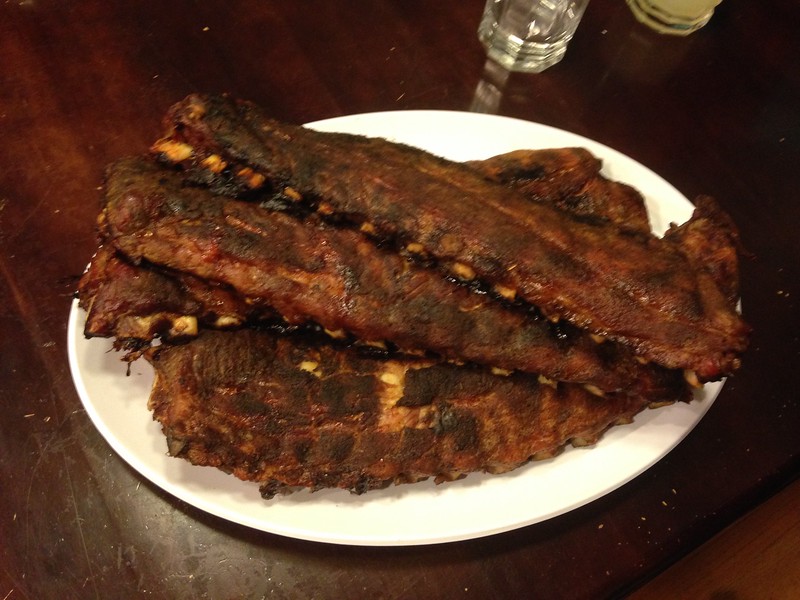
They were great. Our friends said that they didn’t need to put sauce on them, which I took as a sign that they turned out well.
One thing that I didn’t expect was how much more meat you get on baby back ribs that you get from a butcher compared to ones that you get at a restaurant. Usually I can eat a half slab of baby backs pretty easily, and a full rack if I’m really hungry. I was stuffed after half a rack. -
Welcome! It looks like you got your KK 23†just about the same time as I did.
What color tile did you get?
-
I do think it’s more of a top vent/Bernoulli issue, at least in my case. Here’s why:
1. I don’t think the prevailing wind was blowing at the bottom vent that morning. The round shape of the top vent means that the Bernoulli effect can happen as long as wind is blowing by in any direction. Besides, even if the wind was blowing directly into the bottom vent, that also means that it’s blowing by the top vent.
2. The bottom vent was only open a crack. The opening at the top has got to be larger than that, even though I only unscrewed the top vent a little bit.
3. Physics. I ran this by my dad, who’s a physicist.
 He agrees that it’s unlikely that wind would force air through the bottom vent to any appreciable degree.
He agrees that it’s unlikely that wind would force air through the bottom vent to any appreciable degree. -
When I made my first pulled pork over the weekend, there was an interesting thing that happened with the temperature. The temperature was probably pretty steady overnight. The grill was holding a steady 230ºF when I started at 11:00 pm, and was at 220ºF at 6:00 am when I checked it.
Then as the sun came up, it got pretty windy outside, and stayed windy for a while. A couple of hours later, I checked the grill, and the thermometer read 325ºF. The pork had an internal temp of 175ºF at that point, so I shut down the vents and let the grill coast until the pork hit an internal temperature of 200ºF.
My question is, why did the temperature jump like that? I don’t think it was a problem with the charcoal per se. The best explanation I have is that when it got windy, the wind blowing past the upper vent drew more air out from the inside of the grill (Bernoulli Principle), causing more air to flow through from the bottom vent through the grill, which got the charcoal burning hotter.
The pork came out really good, so I’m not particularly worried about whether this is an issue. But I was curious as to why this happened.
-
I know that there are plenty of pulled pork writeups, but this is my first time ever trying out a low-and-slow cook. After the day of Korean BBQ, I tried my hand at cooking a Boston Butt for the first time. I used a basic procedure (coat the pork with rub, put it on the grill fat cap side down at 225ºF, and let it go until the internal temperature gets to 195-200ºF), and I used Melvin’s Bar-B-Que Dry Rub Shake, mainly because I had it on hand. This was given to me as a gift a while ago, and this was the first opportunity I had to use it.
Before:
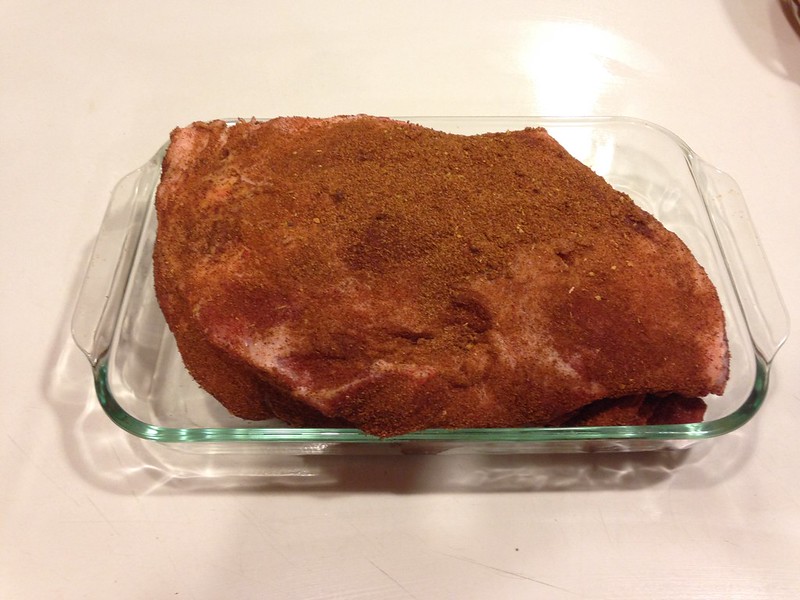
After:
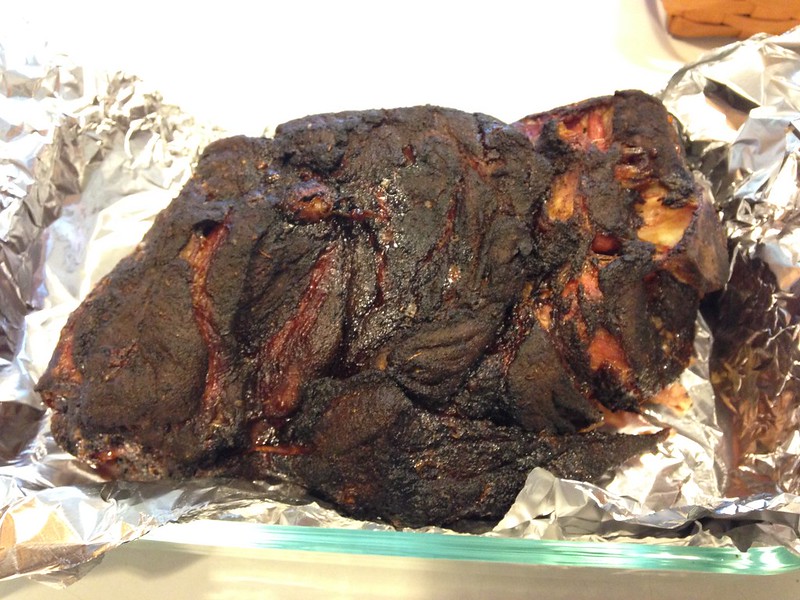
And pulled:
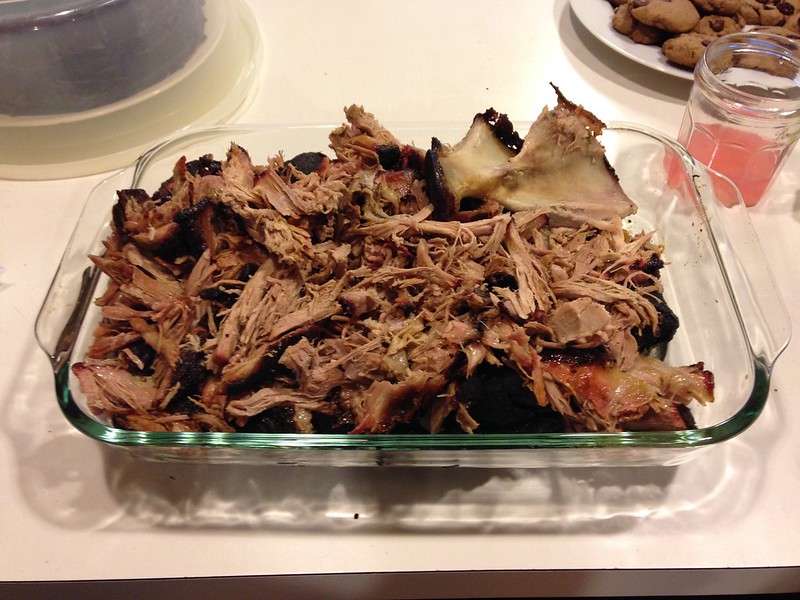
It was delicious. We made pulled pork sliders with some friends for dinner tonight.
The most interesting part of this was the logistics. When I started cooking the Korean BBQ, it was about 1 PM Saturday. I did a second round of cooking at about 4 PM. I knew I wanted to start the pulled pork yesterday evening to make sure it was done before our friends got here, but my grill’s thermometer was reading a good steady 450ºF even after the second round of cooking was done. I wound up starting the pork at 11 PM Saturday night at a temp of 225ºF. The pork was probe tender at 9:30 AM Sunday morning. I then grilled some Korean BBQ leftovers at about 4 PM that afternoon.
I think my grill will really appreciate the break I’m giving it today. It hasn’t been at ambient temperature for the past 30+ hours.
It hasn’t been at ambient temperature for the past 30+ hours.-
 1
1
-
-
Thanks for the fascinating post, Wilburpan. I love Korean BBQ but the few times I've tried to make kalbi or bulgogi, I feel like I don't have the right balance even though I use the fresh Asian pear. So I'm delighted to hear that I should try a bottled sauce from the Asian market!! Also would be very interested in hearing about the recipes and techniques for the side dishes sometime.
Unfortunately, I don’t have recipes for the sides. We picked up the sides at the Korean grocery store, much like you would pick up potato salad at the deli.
Here’s the scoop on how I settled on bottled marinade for Korean BBQ. My sister teaches high school Chinese, and as such she has a lot of Korean students. She was on a quest for a kalbi marinade recipe and asked her Korean students for some. The recipes were all okay, but none of them were outstanding.
Finally, she realized that she was asking for the wrong thing. Instead of asking for recipes, she started asking her Korean students, “How do your parents make kalbi at home?â€
And the answer was universally, “First, they get a bottle of marinade from the Korean grocery store.â€

-
Here’s how to eat Korean BBQ. The kalbi is cut down to smaller pieces. A leaf of Romaine lettuce, some rice, and a dab of soybean paste are put together, and a piece of kalbi is put on top. The Romaine lettuce leaf serves as a way to hold it all together, and you eat it sort of like a lettuce taco stuffed with rice and kalbi meat.
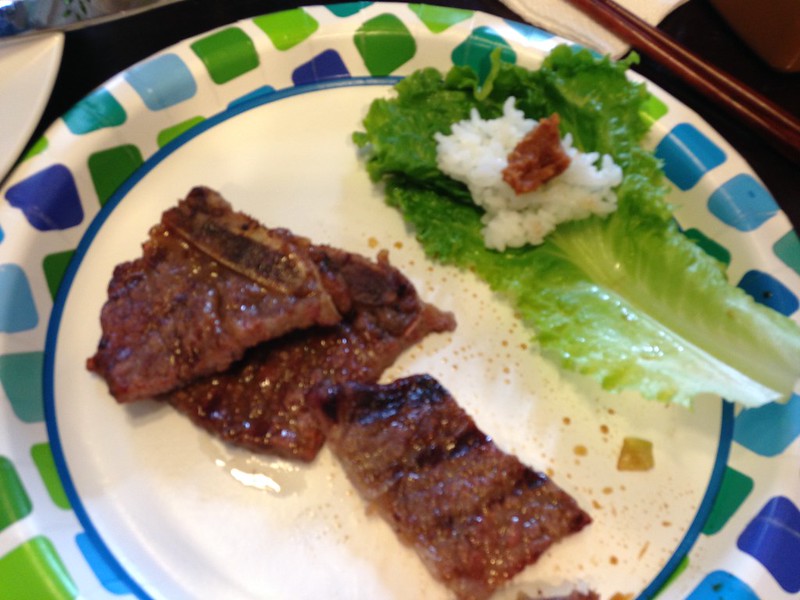
There are other cuts of meat that can be served for Korean BBQ. My second favorite to kalbi is thinly sliced pork belly. This goes straight onto the grill without marinating or a rub. Here are the before and after pictures.
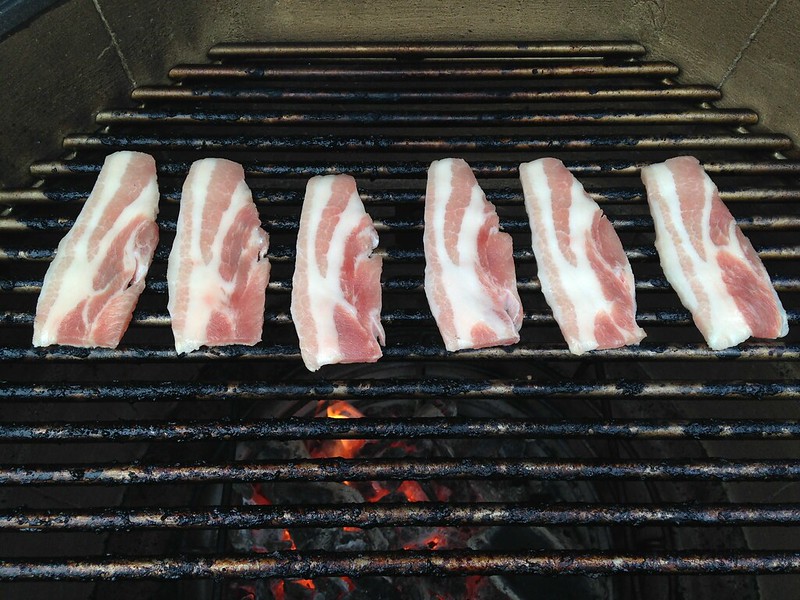
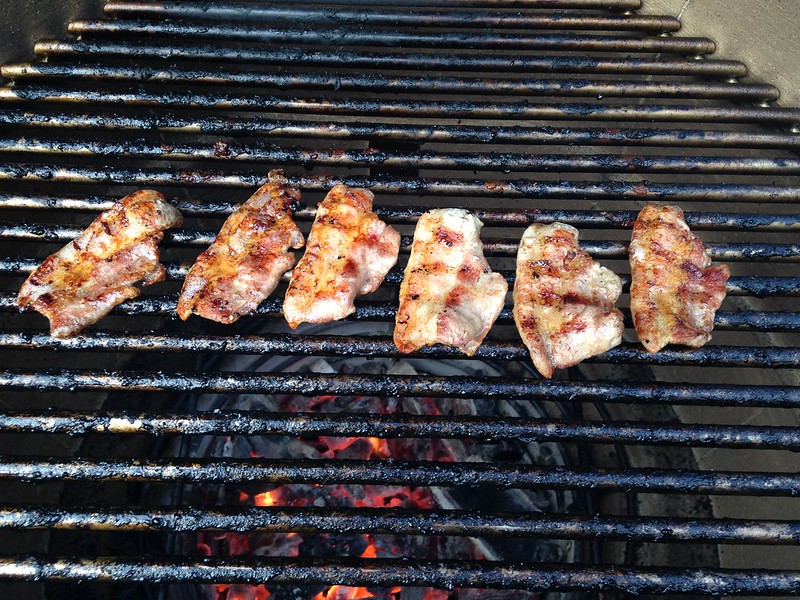
The grilled pork belly is eaten in the same lettuce taco setup as the kalbi, except that instead of soybean paste, I like to use a mix of salt and sesame oil.
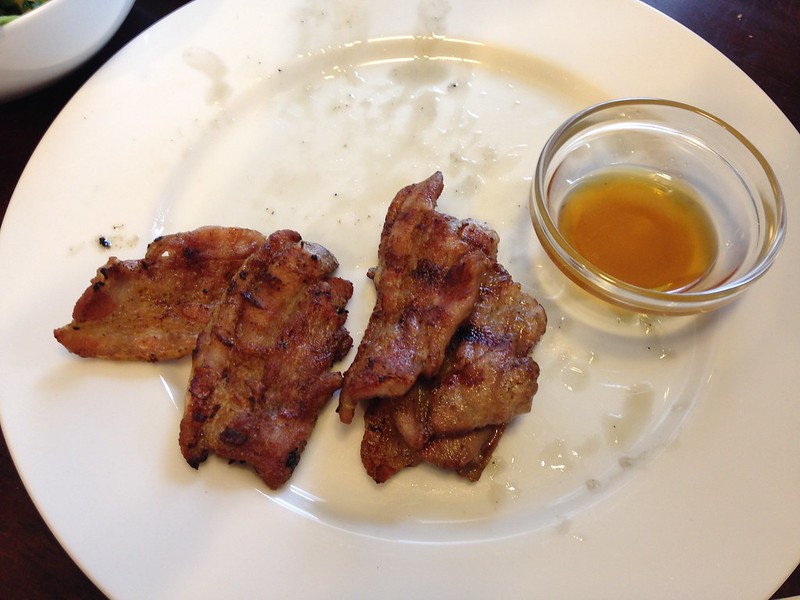
I also used the grill for more than cooking meat. One of our side dishes was seafood pancake, sort of like a pancake-like omelet with seafood incorporated into it. The grill was perfect for heating up the seafood pancake.
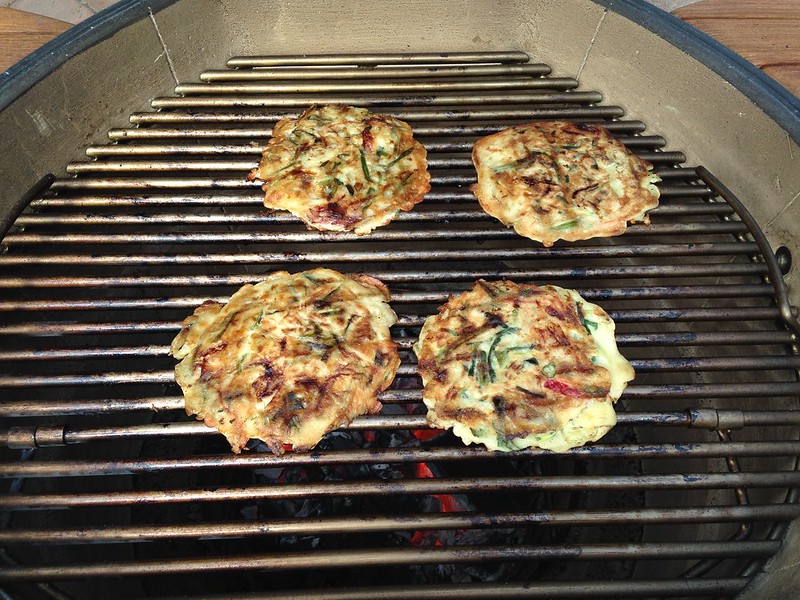
And finally, here’s a shot of the other side dishes we had. Clockwise around the plate of kalbi, there’s marinated spinach, spicy fish cake, seafood pancakes, and edamame.
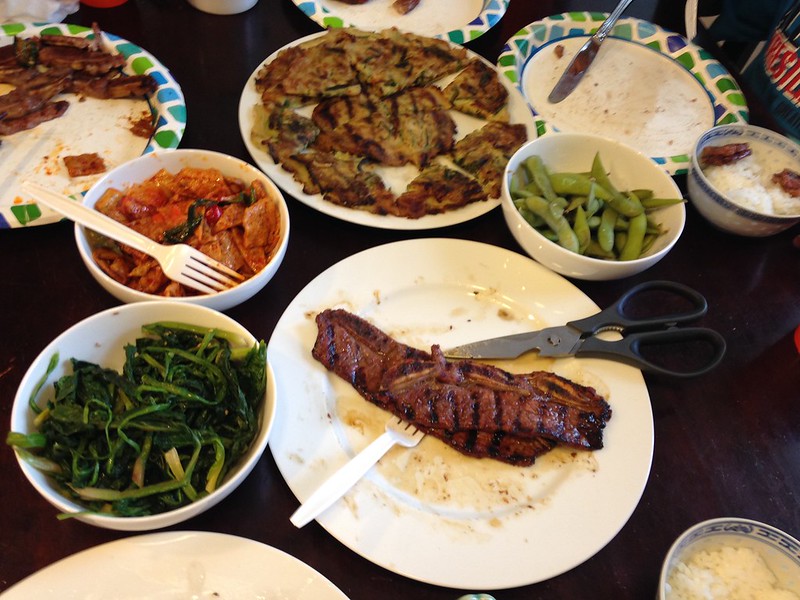
If you’ve never tried Korean BBQ, it’s terrific. I’m so happy that I can make it at home again.
-
 1
1
-
-
One of the things I’ve been craving since I went without a grill for most of the summer was Korean BBQ. I’ve seen some posts here on Korean BBQ-inspired dishes that look great, but nothing that seemed like how it’s traditionally done, so I thought I’d share how we do it.
First, the choice of meat. We really like kalbi, which is beef short ribs cut specifically for Korean BBQ. There are two ways of doing this cut. The most common method is to slice the ribs thinly across the ribs, and they are portioned in three-rib chunks. The second is to slice the meat around the rib thinly in such a manner that you get one continuous strip of meat and the rib at one end. The first method is a less labor-intensive cut than the second method, and the two cuts are priced accordingly.
The first step in making the kalbi is to marinate the meat. There are a lot of recipes out there for kalbi marinades, but we do what every Korean family I know does: use a bottled marinade. If you have access to a Korean grocery store, you’ll find all kinds of marinades, which can be overwhelming. But it’s easy to pick one out.
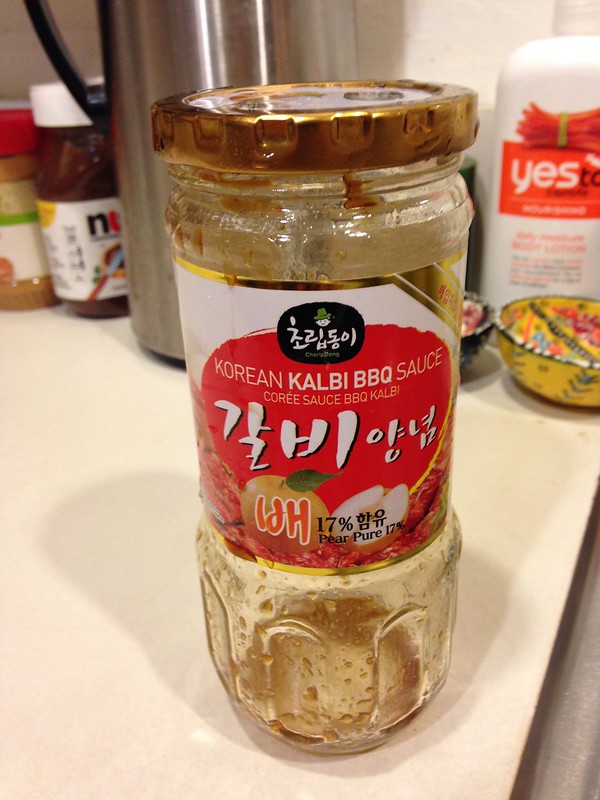
On the label at the top, you’ll see it says, “Kalbi BBQ Sauceâ€. This is your tip that you have the right marinade, as opposed to the marinade for bulgogi or other meats. The second is at the bottom of the label, where it says “Pear Pure 17%â€. Asian pear is a staple of many Korean BBQ marinades, much like how many BBQ guys incorporate apple juice into their cooks. You want the bottle with the highest concentration of Asian pear. And that’s all there is to know about picking out the marinade, even if you don’t know a single word of Korean.
Marinating the meat is pretty straightforward. Just pour the marinade over the meat. I usually use a glass baking dish with a lid for this. The bottle says that 30 minutes of marinating is enough, probably because the slices of meat are so thin. Having said that, if I can marinate overnight, I will.
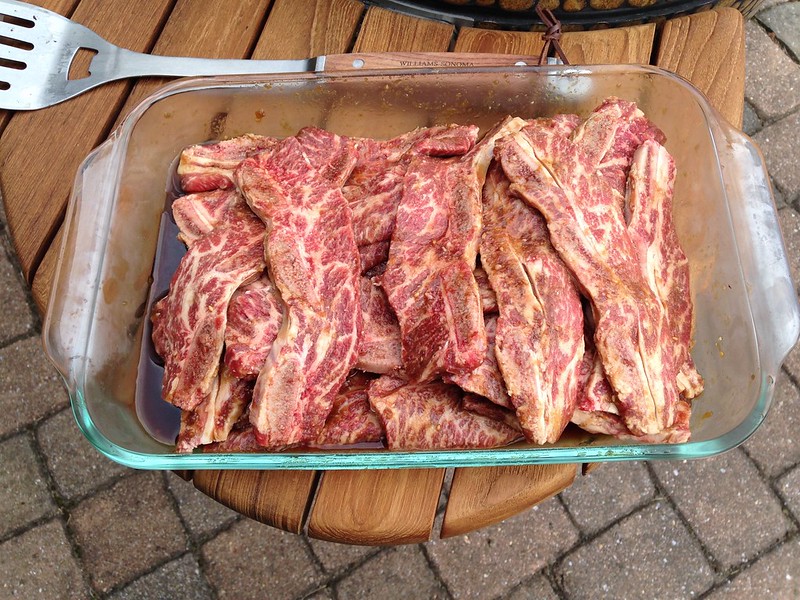
After that, it’s just direct grilling over high heat. I waited until my grill hit an internal temperature of 500ºF. Here are the action shots. First, the three rib cut.
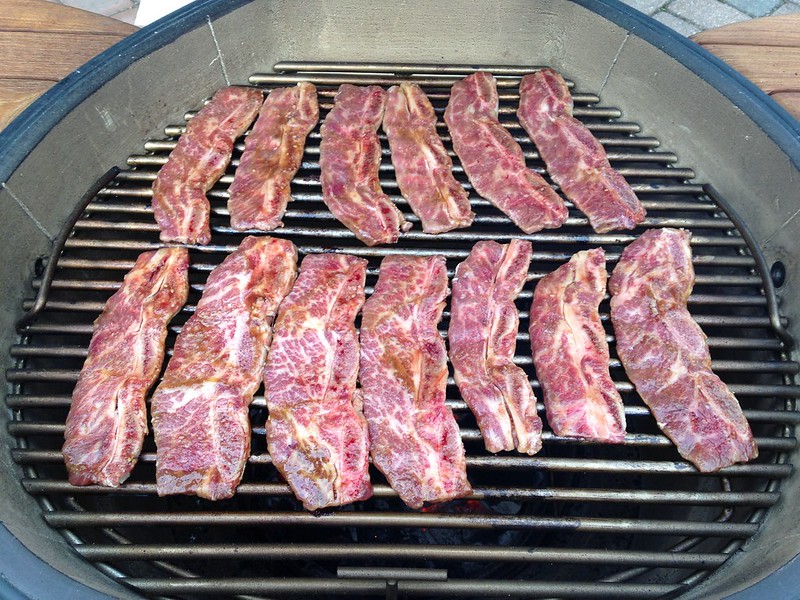
And the more expensive cut. The top three pieces are pork belly. The middle piece has the bone still attached on the left, the right is off the bone.

Hot off the grill.

To be continued, since there seems to be a picture limit.
-
Hi Ken!
Great to see you over here. Looking forward to all your posts, as always.
-
I know I could figure this out by trial and error, but I thought I could prevent some poorly cooked meals by asking first.
As the title says, if you’re direct grilling, what foods would you grill on the main grate, and what would you use the lower/searing grate for?
So far, I have portobello mushrooms, hot dogs and fish on the main grate, seared tuna (duh) on the lower grate.
I’m guessing that steak works better on the lower grate. Burgers I’m undecided as of yet. I’ve tried burgers on the main grate, and they were less done than I would have liked, but I think I may have just taken them off too soon.
Thanks!
-
Thanks for the reminder. I’m all over the burping the lid thing.

-
Yesterday I cooked my second meal on my KK 23â€. It wasn’t anything fancy, just Chicago style hot dogs.
The main thing that has impressed me so far in terms of using my KK 23†for direct grilling is how fast the grill comes up to temperature. I’ve been starting the fire using one of those propane weed burners. It only takes 15 seconds to get the top chunks going. With the bottom vent about 1/2 open and the top vent open 3 turns or so, the thermometer hit 500ºF in only 10 minutes or so. That’s about how long it took my old gas grill to heat up for direct grilling.
Yesterday I cooked the initial batch of hot dogs, and shut down the vents. 20 minutes later, I needed to cook an additional one, and saw that the internal temperature was down to about 350ºF. I opened up the vents again, and was back to 500ºF in about 5 minutes.
My conclusion: what I really have is a charcoal grill that’s as efficient as a gas grill. For me, that’s pretty impressive, and that’s without trying low-and-slow cooking (so far).-
 1
1
-
-
They loved it.

-
Just finished dinner after trying my new KK 23" for the first time. After consulting with the kids, who have been waiting all summer for me to cook on the grill, we decided on fish for the maiden voyage. Everything here was direct grilled at 400ºF or so. I sprinkled a mix of kosher salt, black pepper, and ancho chile powder on the fish. The portobello mushrooms got a coat of olive oil, kosher salt, and black pepper.
Mahi mahi:
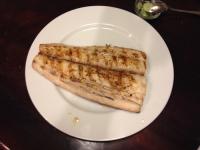
Tuna steak, plated with broccoli rabe and sliced grilled portobello mushroom:
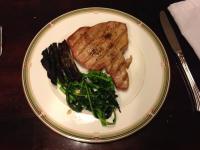
Portobello mushrooms:
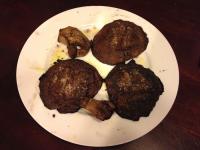
Action shot:
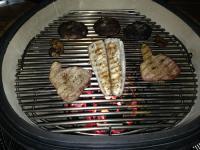
Everything was delicious, although the tuna was overdone for my liking. That was my fault. I didn’t have the grill hot enough for a nice sear. I should have cooked the mahi mahi and mushrooms first, and then brought up the temperature. Learning curve, you know. Still, not bad for using a kamado for the first time.
Still, not bad for using a kamado for the first time.-
 1
1
-
-
A couple of 32's should do the trick...
Robert
If only you knew someone that could supply them.

-
I definitely will keep you in mind, then. I’ll see how long these two boxes last me.
-
Folks, load up on CoCo when you order your grill. If I remember correctly, Dennis can pack like 15 boxes in the crate with an OTB-23" and it doesn't affect shipping price.
Now you tell me.


Big beef "short ribs"
in KK Cooking
Posted
Nice!